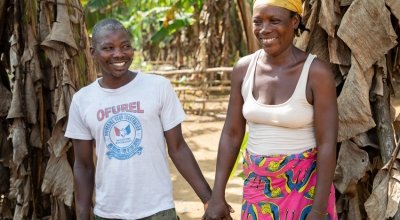
Read our 2023 annual report

Knowledge Hub
Sierra Leone: the long, hard road to Zero+42

Last Saturday, 7 November, marked 42 days since the last reported case of Ebola Virus Disease in Sierra Leone – twice the maximum incubation period. According to the World Health Organisation, this means that the outbreak has officially ended. Concern Worldwide’s Sheena McCann played a crucial, if unlikely, role in stopping the virus. I met her on a recent trip to the country.
The rain beats steadily down on the red earth of Freetown as Sheena McCann dons her wellies and pulls on a pink raincoat. As the diminutive Irish woman climbs down from a Land Cruiser, cries of “Aunty Sheena!” ring out through the wet morning air. This is Kingtom cemetery, a place which will forever be associated with the Ebola virus.
“We buried 6,395 people here between October and March,” says McCann. “At one stage we were burying upwards of 80 people a day.” Because of a government decree designed to halt the spread of Ebola, everyone who died in Freetown during the outbreak was given a full medical burial. Traditional funeral practices in West Africa had been a major factor in the spread of the virus. Last October, Concern Worldwide and the International Federation of the Red Cross took over what was then a very chaotic burial system. Between them they have since collected and buried over 16,000 bodies.
Dark days
Two cemeteries in the Freetown area were designated for use during the crisis, and the management of both fell to Sheena McCann. A native of Belcoo in County Fermanagh and an accountant by profession, she has spent the last decade and a half working for Concern in some of the least hospitable places on earth. But nothing could have fully prepared her for this.
“I suppose there’s a certain logic to burial grounds – trying to manage the space, making sure the records are accurate and figuring out a system to cope with the demand,” McCann told me. And during those dark days of late 2014 the demands were huge, with cool heads needed to prevent total chaos.
If you can imagine dozens of burials every day, carried out by teams in full protective gear and with all the people and activity that goes alongside that, it was quite a challenge. But we managed.

As space ran short, new ground was cleared and hundreds of new graves were dug by hand each week. At one stage Concern was employing nearly 300 people and managing a fleet of 36 vehicles to keep the whole system going. Eventually, all burials were transferred to another site at Waterloo, just outside the city. Over 9,000 graves line the hillside there.
Assuring dignity
Looking out across row after row of headstones, Sheena McCann continues:
Alongside preventing the spread of Ebola, what we really wanted to do was to make sure that families could say goodbye to their loved ones with dignity and to know exactly where they were buried. Previously many bodies had been buried in unmarked mass plots.
Today, with the Ebola threat having receded, the only activity at Kingtom is the continuing installation of permanent grave markers by cemetery workers and the occasional visit by family members. The oldest cemetery in Freetown has now become the newest and it will for generations to come be known as “the Ebola graveyard”, despite the fact that many buried here almost certainly did not have the virus.

An extraordinary year
The medical burial system, which is generally acknowledged as having played a key role in the fight against Ebola, will now be decommissioned. The men and women who risked their lives daily to do one of the hardest jobs on the planet, often facing ostracisation for their efforts, will be helped to find new sources of income and to re-integrate into their communities.
Reflecting on what has by any standards been an extraordinary year, the logistician in Sheena McCann drops away and her face softens. “There were days when you had to stop and remind yourself what you were doing – especially when you saw the children’s burials,” she says.
When you see a burial team member carrying a child in a little white body bag with great respect and dignity, and placing it in a grave… that takes your breath away. You realise that this was somebody’s child.
Follow Concern
Keep up to date with all of our work by following us on Instagram.





